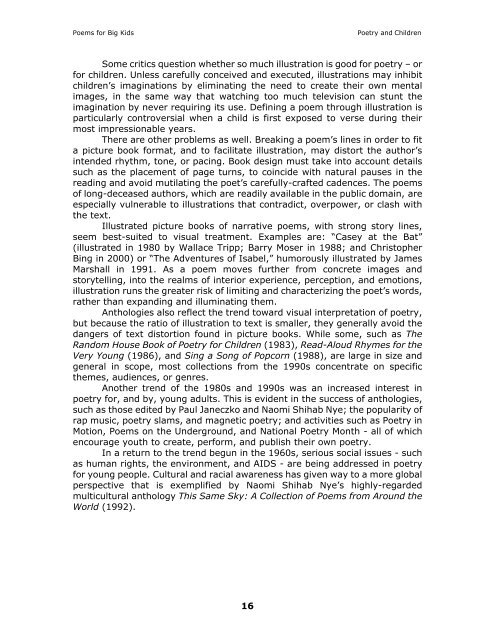You also want an ePaper? Increase the reach of your titles
YUMPU automatically turns print PDFs into web optimized ePapers that Google loves.
<strong>Poems</strong> <strong>for</strong> <strong>Big</strong> <strong>Kids</strong> Poetry and Children<br />
Some critics question whether so much illustration is good <strong>for</strong> poetry – or<br />
<strong>for</strong> children. Unless carefully conceived and executed, illustrations may inhibit<br />
children’s imaginations by eliminating the need to create their own mental<br />
images, in the same way that watching too much television can stunt the<br />
imagination by never requiring its use. Defining a poem through illustration is<br />
particularly controversial when a child is first exposed to verse during their<br />
most impressionable years.<br />
There are other problems as well. Breaking a poem’s lines in order to fit<br />
a picture book <strong>for</strong>mat, and to facilitate illustration, may distort the author’s<br />
intended rhythm, tone, or pacing. Book design must take into account details<br />
such as the placement of page turns, to coincide with natural pauses in the<br />
reading and avoid mutilating the poet’s carefully-crafted cadences. The poems<br />
of long-deceased authors, which are readily available in the public domain, are<br />
especially vulnerable to illustrations that contradict, overpower, or clash with<br />
the text.<br />
Illustrated picture books of narrative poems, with strong story lines,<br />
seem best-suited to visual treatment. Examples are: “Casey at the Bat”<br />
(illustrated in 1980 by Wallace Tripp; Barry Moser in 1988; and Christopher<br />
Bing in 2000) or “The Adventures of Isabel,” humorously illustrated by James<br />
Marshall in 1991. As a poem moves further from concrete images and<br />
storytelling, into the realms of interior experience, perception, and emotions,<br />
illustration runs the greater risk of limiting and characterizing the poet’s words,<br />
rather than expanding and illuminating them.<br />
Anthologies also reflect the trend toward visual interpretation of poetry,<br />
but because the ratio of illustration to text is smaller, they generally avoid the<br />
dangers of text distortion found in picture books. While some, such as The<br />
Random House Book of Poetry <strong>for</strong> Children (1983), Read-Aloud Rhymes <strong>for</strong> the<br />
Very Young (1986), and Sing a Song of Popcorn (1988), are large in size and<br />
general in scope, most collections from the 1990s concentrate on specific<br />
themes, audiences, or genres.<br />
Another trend of the 1980s and 1990s was an increased interest in<br />
poetry <strong>for</strong>, and by, young adults. This is evident in the success of anthologies,<br />
such as those edited by Paul Janeczko and Naomi Shihab Nye; the popularity of<br />
rap music, poetry slams, and magnetic poetry; and activities such as Poetry in<br />
Motion, <strong>Poems</strong> on the Underground, and National Poetry Month - all of which<br />
encourage youth to create, per<strong>for</strong>m, and publish their own poetry.<br />
In a return to the trend begun in the 1960s, serious social issues - such<br />
as human rights, the environment, and AIDS - are being addressed in poetry<br />
<strong>for</strong> young people. Cultural and racial awareness has given way to a more global<br />
perspective that is exemplified by Naomi Shihab Nye’s highly-regarded<br />
multicultural anthology This Same Sky: A Collection of <strong>Poems</strong> from Around the<br />
World (1992).<br />
16



